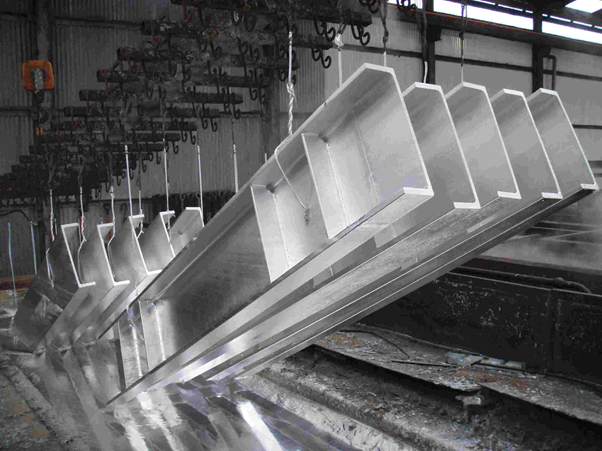How to make steel even more durable? How can we minimize the need for maintenance of future structures made of it? Let’s find out what is a galvanizing process.
In a nutshell, hot-dip galvanizing involves the process of mechanically applying a durable zinc coating to steel. The reaction between zinc and steel takes place in liquid zinc, most often at a temperature of 445 to 460 ° C. The steel goes into the bath for a maximum of several minutes, after which it cools down – only then the internal structure of the zinc coating gets its final form.
The result of this treatment is a durable, impermeable coating that protects the steel due to its special electrochemical system. Importantly, the layer formed as a result of the reaction between iron and zinc adheres closely to the steel and even if it cracks, the corrosion will only affect the coating, not the steel.
Hot dip galvanizing process
The zinc coating is a very durable and effective barrier that separates steel from the corrosive environment. There are several technological methods of zinc application, of which hot-dip galvanizing is the most universal, as it works well for both small elements and large steel structures.
The hot-dip galvanizing process consists of several preliminary stages, preceding the direct immersion of the steel element in liquid zinc, resulting in a mechanically durable and impermeable zinc coating that protects the steel material against corrosion and thus prevents steel deterioration.
The stages of the galvanizing process:
Abrasive blasting
The first stage of the process is to mechanically remove the inhomogeneities adhering to the surface of the galvanized object. Pollutants, i.e. sand, rust, scale, slag, or remains of the old anti-corrosion coating are removed by abrasive blasting.
During processing, a stream of compressed air enriched with abrasive material (i.e. cast steel, cast iron, grains cut from steel wire) is directed to the surface subjected to mechanical cleaning. Depending on the type of abrasive used and the speed with which it hits the object, the effect of smoothing, hardening, heating, deforming, or strengthening the surface structure is obtained.
Abrasive blasting is an economical and environmentally safe method. Another example of preparing small-sized steel elements for zinc coating is vibro-abrasive machining. This term describes the mechanical smoothing or polishing of surfaces, removal of gas corrosion products, and rust. These processes are carried out in vibrating smoothing machines, wet with the addition of chemicals, abrasives, and synthetic resins of various shapes and abrasion efficiency.
A specific type of abrasive processing is tumbling, in which the impact of the abrasive material on the steel surface takes place in the mixing device during the rotational movements of the drum.
Degreasing
Before immersion in a zinc bath, steel elements should be free from grease, waxy substances, and oil that prevent the reaction of iron with zinc. The degreasing step is to obtain a chemically clean surface on which a steel-zinc alloy will be formed. Many inorganic solutions with alkaline, acidic, and neutral pH have cleaning and degreasing properties.
Chemical Cleaning
It enables the effective removal of non-metallic substances (i.e. rust, scale, and other corrosion products) formed during rolling and annealing of structural elements. The most popular method of digestion is a hydrochloric acid bath. In exceptional situations, when the removal of sand from cast iron elements by etching in hydrochloric acid does not bring the expected results, a solution of hydrofluoric acid or a mixture of hydrochloric and hydrofluoric acids can be used.
Fluxing:
The acid-etched steel enters the next phase known as fluxing. This stage consists of immersing the steel elements in an aqueous solution of zinc chloride and ammonium chloride (ZnCl2 / NH4Cl) in order to ensure the proper course of chemical reactions taking place during galvanization. In the dry method, ammonium chloride constitutes 15% of the solution, while in the wet method, the salts are present in the proportion of 1: 3. The task of fluxes is to clean steel surfaces from traces of oxides, which effectively minimizes the risk of steel oxidation before its introduction into a liquid zinc bath.
Drying:
After treatment in the flux bath, the steel parts are dried at a temperature of 120 ° C-150 ° C. This is a stage that requires high precision and special care. It is important to constantly monitor the temperature of the system. A rapid change in thermal conditions may ignite the chemical substances contained in the flux and reduce the effectiveness of the treatment. Drying should be carried out efficiently and quickly in order to prevent the digestion of the iron and the formation of iron compounds which adversely affect the processes involving fluxes.
Galvanizing:
The last stage of the hot-dip galvanizing process consists of immersing the previously prepared steel substrate in a bath of molten zinc at a temperature of 445 ° C-455 ° C. Under these conditions, zinc and iron undergo a very rapid chemical reaction, which reduces the time of immersion of steel surfaces in liquid zinc to several minutes. By diffusion, i.e. the penetration of zinc atoms into the outer steel layer, a surface iron-zinc alloy is formed, containing a different ratio of both components. Fire zinc coating after cooling in water is characterized by high mechanical resistance and aesthetic appearance.


